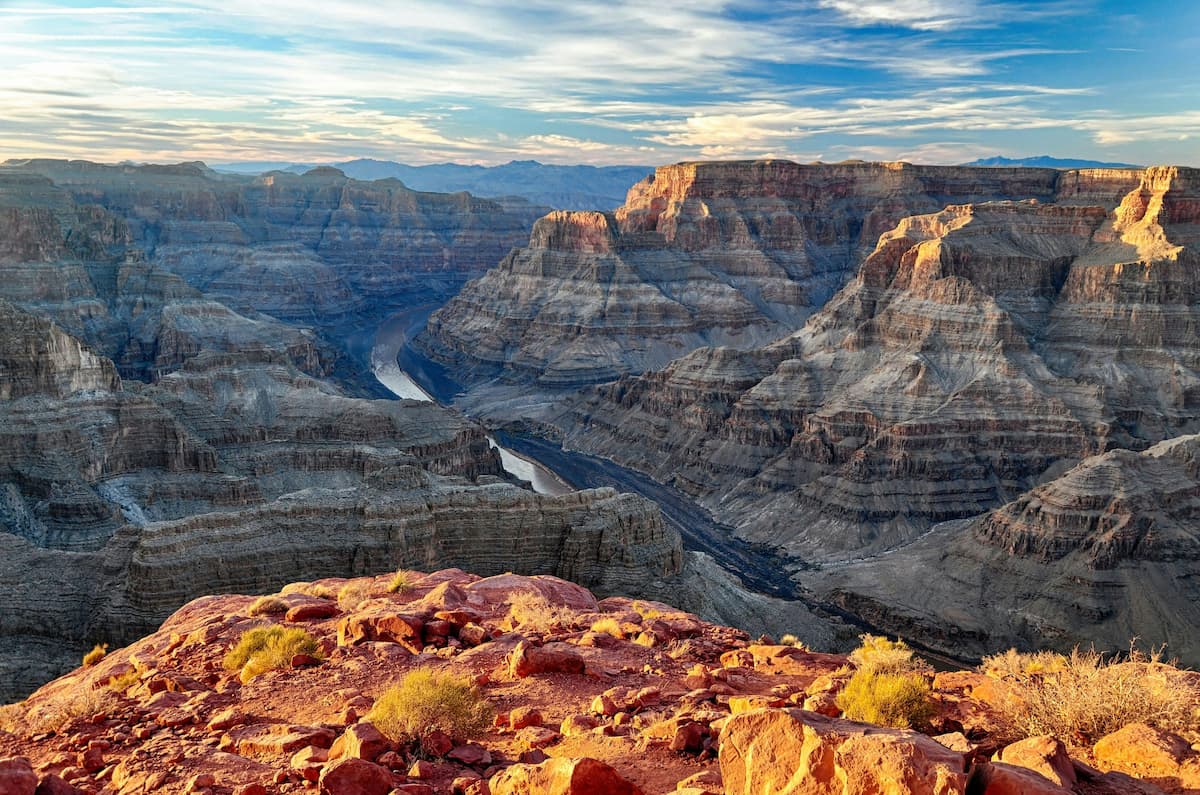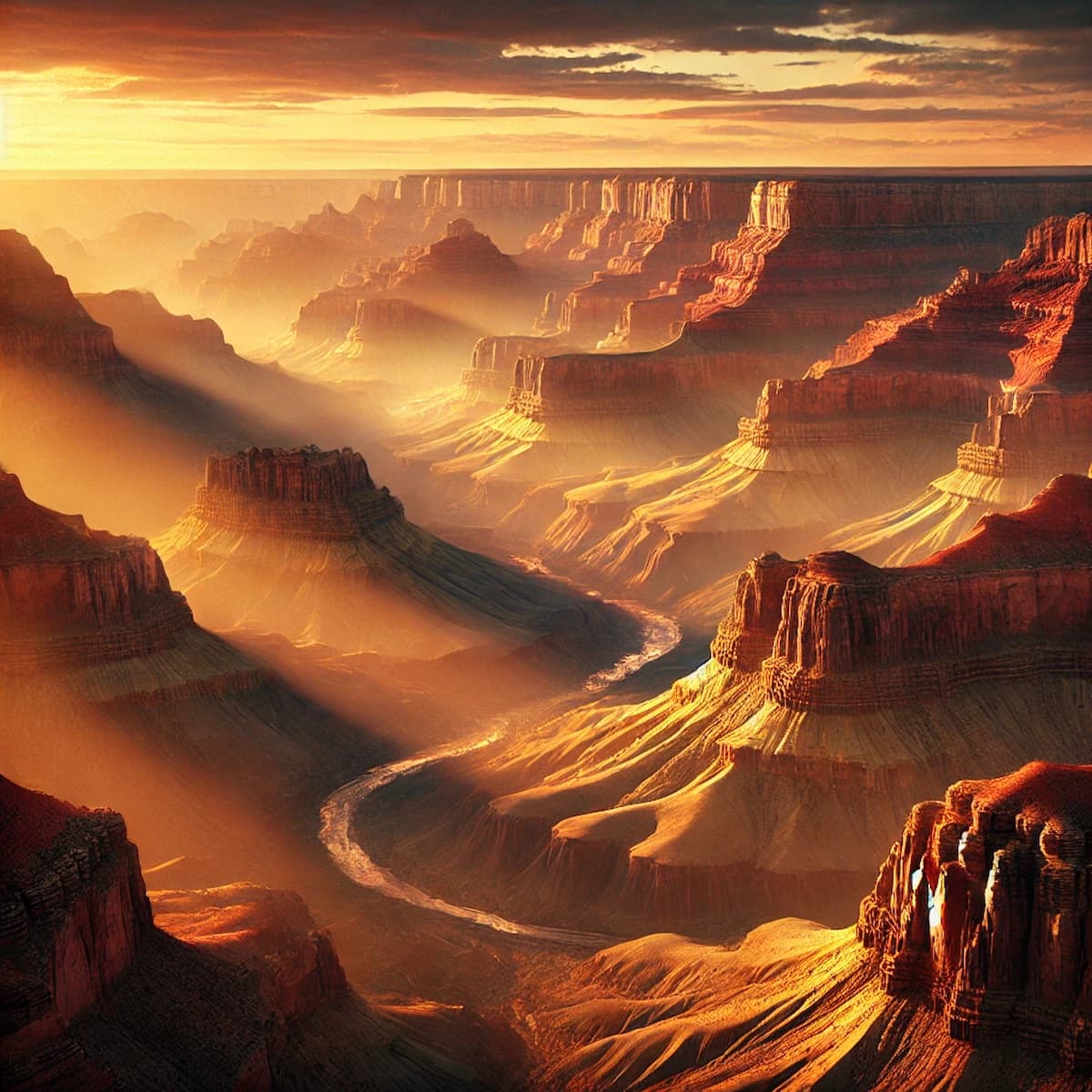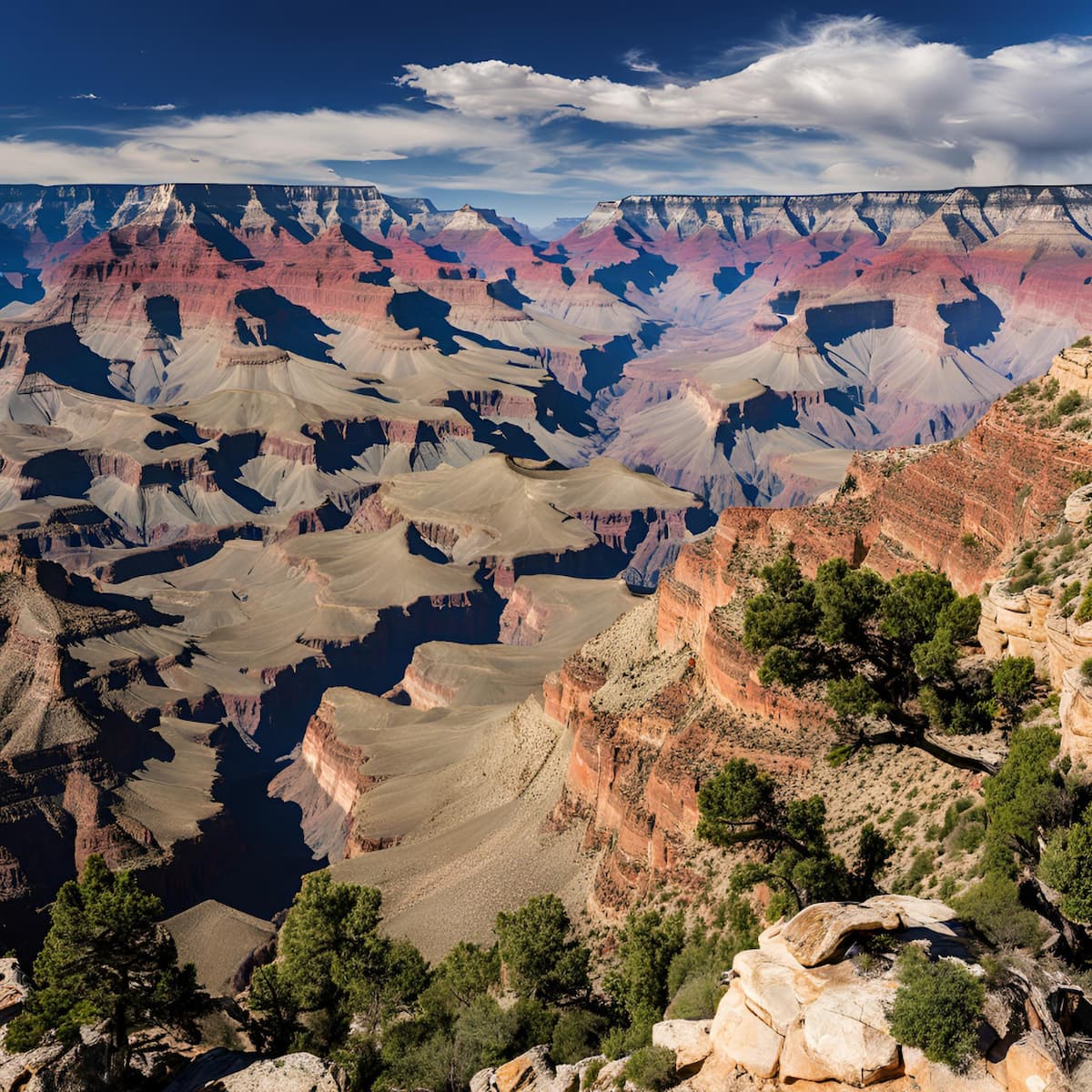
Watch short for this article (5 slides)
Grand Canyon: A Journey Through Earth's History, Carved by Water and Time
Grand Canyon National Park in Arizona stands as one of Earth's most profound geological spectacles and a globally recognized icon of the American Southwest. It's not merely a canyon, but a vast, intricate chasm stretching 277 river miles (446 km) long, up to 18 miles (29 km) wide, and plunging over a mile (1.6 km) deep. Carved relentlessly by the Colorado River over millions of years, its layered rock walls expose a nearly unparalleled cross-section of geological time, revealing billions of years of Earth's history. This immense scale, combined with dramatic vistas, vibrant colors that shift with the light, and diverse ecosystems, creates an experience of awe and perspective unlike any other, drawing millions to witness its majesty.

Photo by Omer Nezih Gerek on Unsplash - The Grand Canyon offers breathtaking views into deep geological time.
The Grand Architect: Unraveling the Canyon's Formation
The creation of the Grand Canyon is a story written in stone, involving two primary geological processes unfolding over immense timescales:
- Uplift of the Colorado Plateau: Beginning around 70 million years ago, broad tectonic forces gradually lifted the Colorado Plateau, a vast region encompassing the Grand Canyon area, thousands of feet above sea level. This uplift was relatively uniform, keeping the rock layers mostly horizontal, which is crucial for the distinct layered appearance of the canyon walls today.
- Downcutting by the Colorado River: As the plateau rose, the ancestral Colorado River maintained its course, acting like a powerful saw cutting downwards through the rising landmass. The river's erosive power, amplified by the steep gradient created by the uplift and armed with abrasive sediment (sand, gravel, boulders) carried in its current, relentlessly carved deeper and deeper into the rock layers. While the exact timing is still debated by geologists (with theories ranging from carving starting 5-6 million years ago to potentially much earlier), the river's persistent downcutting is the primary force responsible for the canyon's depth.
Simultaneously, weathering processes (ice wedging, rain, wind) and erosion by tributary streams worked to widen the canyon, creating the complex network of side canyons, mesas, and buttes that contribute to its immense scale. Differential erosion played a key role: harder, more resistant rock layers like the Coconino Sandstone and Kaibab Limestone form steep cliffs, while softer layers like the Bright Angel Shale erode more easily, creating gentler slopes and benches between the cliffs.
A Geological Library: Reading the Rock Layers
The canyon walls expose a remarkable sequence of rock layers, offering a tangible timeline of Earth's history:
- Vishnu Basement Rocks (Inner Gorge): At the very bottom, dark, metamorphic rocks like Vishnu Schist and Zoroaster Granite date back nearly 2 billion years – remnants of ancient mountain ranges formed long before multicellular life flourished.
- Grand Canyon Supergroup (Tilted Layers): Visible in some parts of the canyon, these sedimentary and volcanic rocks were deposited between 1.2 billion and 740 million years ago, then tilted and eroded before the next layers formed.
- Paleozoic Era Strata (The Main Layered Sequence): Forming the bulk of the visible canyon walls, these distinct, horizontal layers were deposited primarily in shallow seas and coastal environments between about 525 million and 270 million years ago. Key layers include:
- Tapeats Sandstone (beach deposits)
- Bright Angel Shale (muddy offshore environment, rich in early fossils)
- Muav Limestone (deeper marine environment)
- Redwall Limestone (forms massive cliffs, stained red by erosion from layers above)
- Supai Group (river and floodplain deposits)
- Hermit Shale (terrestrial mudflats)
- Coconino Sandstone (petrified desert sand dunes)
- Toroweap Formation (shallow sea/coastal plain)
- Kaibab Limestone (Rim Rock): The uppermost layer forming the rim, deposited in a warm, shallow sea around 270 million years ago.
These layers provide invaluable insights into past environments, climates, and the evolution of life on Earth. (Source: NPS - Grand Canyon Geologic Formations)
Experiencing the Immensity: Vistas from the Rims
The sheer scale of the Grand Canyon defies easy comprehension and offers vastly different experiences depending on location and time of day.
- The South Rim: Accessible Grandeur: Open year-round and receiving the vast majority of visitors, the South Rim sits at an average elevation of 7,000 feet (2,134 m). It offers iconic, expansive panoramic views into the heart of the canyon.
- Key Areas: Grand Canyon Village houses historic lodges, visitor centers, and access points. Mather Point (near the main Visitor Center) offers a stunning first impression. Yavapai Point and Geology Museum provide excellent geological context alongside the views.
- Rim Trail: A mostly paved, relatively flat trail stretching for 13 miles (21 km) along the rim offers numerous viewpoints accessible by walking or park shuttle bus (west of the village). Popular stops include Hopi Point (renowned for sunset), Mohave Point, and Hermits Rest.
- Desert View: Located 25 miles east of the village, the historic Desert View Watchtower (designed by Mary Colter) provides unique perspectives towards the eastern end of the canyon and the Painted Desert beyond.
- The North Rim: Solitude and Elevation: Higher, cooler, and more remote, the North Rim (average elevation 8,000 feet / 2,438 m) offers a different character. It's open seasonally (typically mid-May to mid-October) due to heavy winter snowfall.
- Feel: Fewer crowds, denser forests (Ponderosa Pine, Spruce, Fir, Aspen), and views often characterized by greater depth perception and prominent landmarks like Bright Angel Canyon.
- Key Viewpoints: Bright Angel Point (near Grand Canyon Lodge), Point Imperial (the highest viewpoint on either rim), Cape Royal (offering sweeping eastern views and Angels Window arch).
- The Magic of Light: The canyon's appearance transforms dramatically throughout the day. Sunrise and sunset paint the cliffs in shifting palettes of gold, orange, pink, and purple as shadows lengthen and define the intricate topography. Midday sun can flatten the perspective but reveal the immensity, while passing clouds create moving patterns of light and shadow across the landscape.

Sunrise and sunset dramatically alter the colors and shadows within the Grand Canyon.
Descending Below the Rim: Adventure and Caution
While rim views are spectacular, venturing into the canyon offers a profoundly different perspective and challenge.
- Inner Canyon Hiking (Extreme Difficulty): Hiking below the rim is strenuous and potentially dangerous due to extreme elevation changes (over 4,000 ft / 1,200 m to the river), steep trails, intense inner canyon heat (especially May-September, where temperatures can exceed 110°F / 43°C), limited water sources, and significant distances. The NPS strongly advises against attempting to hike from the rim to the river and back in a single day.
- Corridor Trails: The best-maintained trails are the Bright Angel, South Kaibab (South Rim), and North Kaibab (North Rim). They offer access to destinations like Indian Garden, Plateau Point, Phantom Ranch (lodge and campground at the bottom, accessible only by foot, mule, or raft - reservations/lottery required far in advance), and rim-to-rim hikes (a multi-day endeavor for experienced, well-prepared backpackers).
- Key Safety: Hikers must carry ample water (at least 1 gallon/4 liters per person per day) and electrolyte replacements, wear appropriate footwear and sun protection, start early, hike during cooler parts of the day, know their physical limits, and be aware of symptoms of heat exhaustion, heat stroke, and hyponatremia (overhydration). (Source: NPS - Hike Smart Grand Canyon)
- Colorado River Rafting: Multi-day rafting trips (ranging from a few days to over two weeks) offer a unique way to experience the canyon from its base, navigating significant rapids and exploring side canyons. These trips require permits (obtained via a highly competitive weighted lottery years in advance for private trips) or booking with commercial outfitters.
- Mule Rides: Guided mule trips descend into the canyon from both the South and North Rims, offering a traditional (though physically demanding) way to experience the inner canyon trails.
Life Zones and Wildlife: A Canyon Ecosystem
The Grand Canyon's dramatic elevation gradient creates distinct life zones, similar to traveling from Mexico to Canada:
- Inner Canyon (Riparian & Desert Scrub): The hottest and driest zone along the Colorado River features desert plants like cacti, agave, and mesquite, plus a vital ribbon of green (willows, cottonwoods) along the river itself. Wildlife includes desert bighorn sheep, rattlesnakes (including the unique Grand Canyon Pink Rattlesnake), collared lizards, canyon wrens, and bats.
- Mid-Elevations (Pinyon-Juniper & Ponderosa Pine): As elevation increases, pinyon pine and juniper woodlands transition into forests dominated by tall Ponderosa pines. Mule deer, rock squirrels, Abert's squirrels (with distinctive ear tufts), and Steller's jays are common.
- North Rim (Mixed Conifer & Spruce-Fir): The cooler, wetter North Rim supports denser forests of Douglas fir, white fir, Engelmann spruce, blue spruce, and aspen groves. Wildlife includes the unique Kaibab squirrel (found only here), porcupines, and goshawks.
- California Condor Reintroduction: One of conservation's great success stories, the critically endangered California Condor (North America's largest land bird with a wingspan up to 9.5 feet) was reintroduced near the Grand Canyon. These magnificent birds can sometimes be seen soaring on thermal updrafts near the canyon rims, often identifiable by wing tags. (Source: NPS - California Condors)

The endangered California Condor can sometimes be spotted soaring above the canyon rims.
A Storied Landscape: Human History and Preservation
Humans have interacted with the Grand Canyon for millennia:
- Indigenous Heritage: Archaeological evidence indicates human presence dating back nearly 12,000 years. Numerous tribes consider the canyon a sacred ancestral homeland, including the Havasupai (who still live within the canyon at Supai Village), Hualapai, Navajo, Hopi, Southern Paiute, Zuni, and Yavapai-Apache. Their history, cultural sites, and spiritual connection are integral to the park's identity.
- Exploration and Protection: Spanish explorers were likely the first Europeans to see the canyon in the 1540s, but it remained largely unknown until John Wesley Powell's pioneering, perilous boat expedition down the Colorado River in 1869. Powell's journey captured national attention. Early conservation efforts led by figures like Theodore Roosevelt (who visited often and declared it a Game Preserve and later a National Monument in 1908) culminated in its designation as a National Park on February 26, 1919. It was later named a UNESCO World Heritage Site in 1979.
- Contemporary Challenges: Preserving the Grand Canyon faces ongoing pressures:
- Water Issues: Dams upstream (like Glen Canyon Dam) have profoundly altered the Colorado River's flow, temperature, and sediment load, impacting beaches, native fish, and riparian ecosystems within the canyon. Ongoing drought and increasing water demands across the Southwest exacerbate these challenges.
- Air Quality & Viewshed: Regional haze from power plants, industry, and urban areas can impair the famously vast views.
- Soundscape Protection: Managing noise from aircraft tours to preserve natural quiet is a persistent issue.
- Development Pressures: Proposals for development near park boundaries raise concerns about impacts on resources, wildlife, and cultural sites.
- High Visitation: Balancing access for millions of visitors with resource protection requires careful management.
Conclusion: An Enduring Monument to Time and Nature
Grand Canyon National Park is far more than just a very large canyon; it is a profound geological narrative, an ecological marvel spanning multiple life zones, a landscape imbued with deep cultural significance, and a global symbol of natural wonder. Its vastness challenges perspective, its layered rocks unveil deep time, and its rugged beauty inspires humility and awe. From the relentless power of the Colorado River still carving its depths to the silent soar of a condor overhead, the Grand Canyon offers an unparalleled experience. Preserving its integrity against modern pressures remains a critical task, ensuring that this testament to the enduring power of nature continues to inspire and educate future generations.